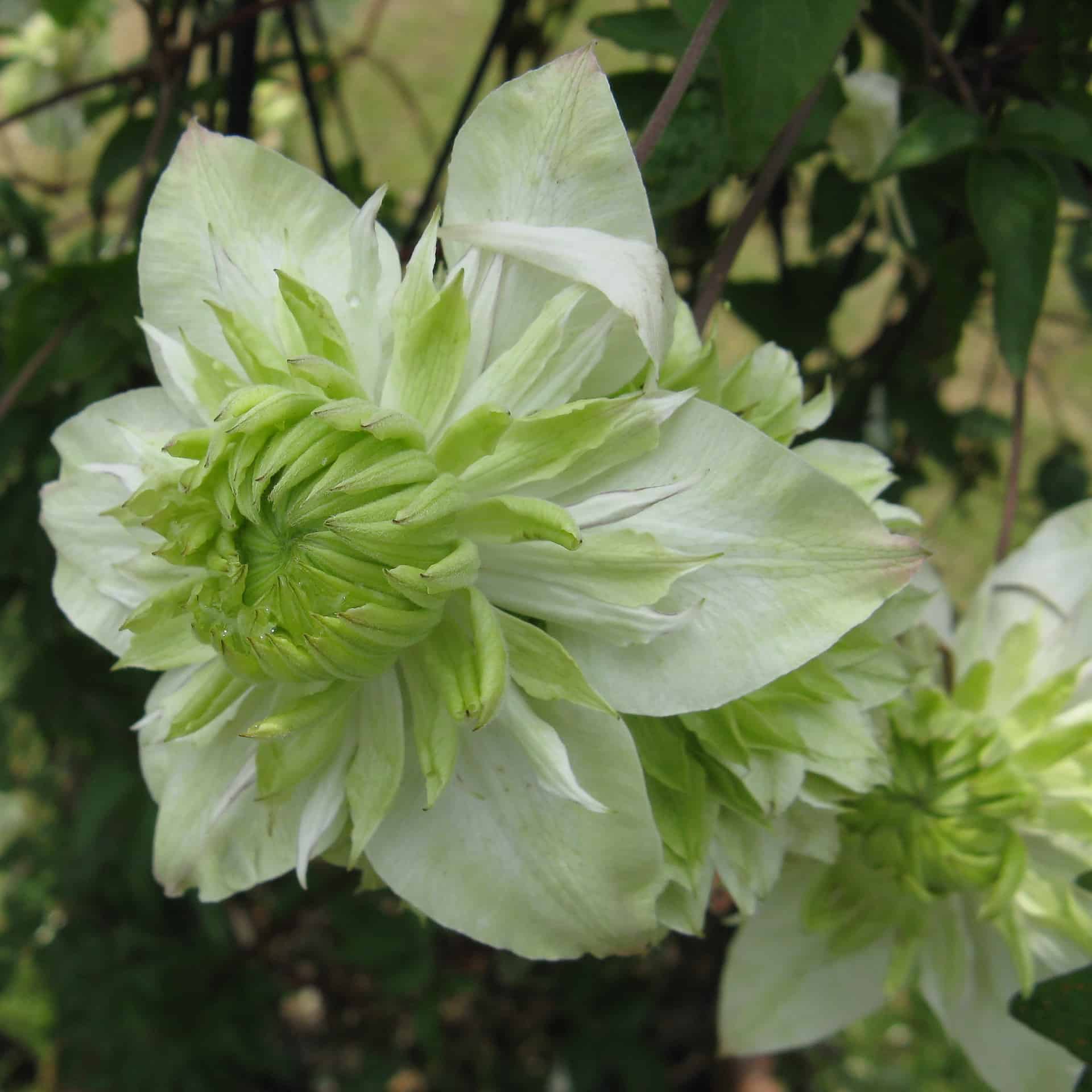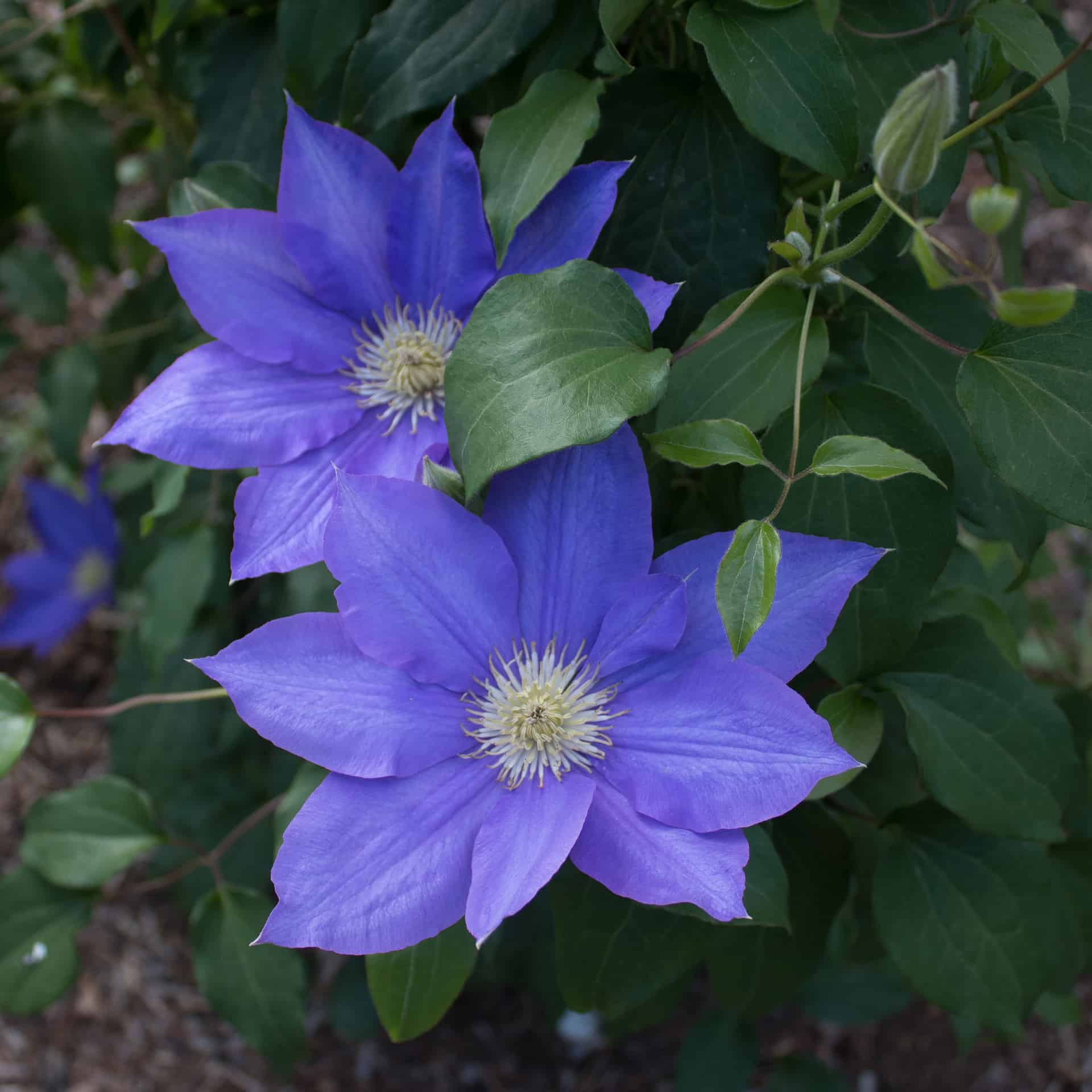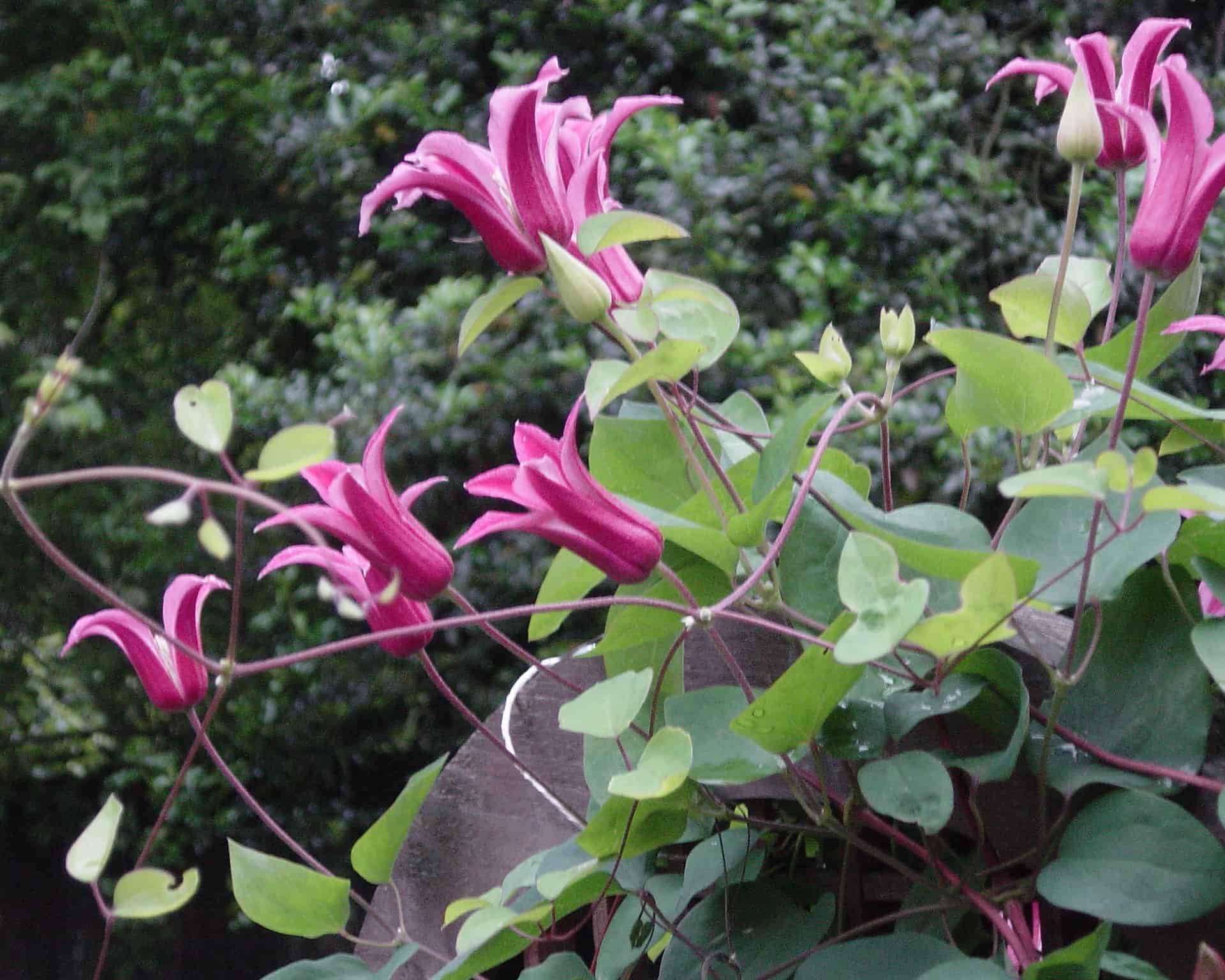No products in the cart.
Clematis flowers make for a beautiful addition to any garden structure. These outdoor plants are easy to grow, with beautiful flowers in different shades of color to brighten up any space.
Still, which types of clematis should you grow, and how should you grow them? To find out more, stay longer as we look deeper at some of our favorite clematis cultivars.
Hopefully, by the end, it will help you decide which will work best in your garden.
More About Clematis Flowers
Globally you can find over 350 clematis flowers growing as perennial climbing vines or shrubs. The plant belongs to the Ranunculaceae or buttercup family. The blooms become large flowers in various shades with five or six petals, and it has pointed tips.
The vining plants grow slowly, and they attract pollinators to garden structures. The best part is they return year after year once they start to grow. The plant gives a vertical attraction and helps save space in small gardens.
Furthermore, clematis has a long flowering season when pruned as they grow multiple stems in the growing season. So, please keep reading to see our colorful collection of clematis to add to your garden wishlist.
The Best Clematis to Grow in The Garden or Large Containers
Add one of these show vines to your garden wishlist this year. You can find richly colored flowers to a deciduous climber with yellow stamens or even dark purple flowers. The choices are endless to provide a splash of color to your early spring the late summer garden.
Addison’s Leather, a Small Flowered Clematis
 Clematis addisonii @flickr
Clematis addisonii @flickr
The Clematis addisonii Britt are perennial flowers from Virginia, and it is a threatened species. This container plant grows to 2.5 feet tall with beige or rose-colored bell-shaped flowers.
The flowers are contrasted with lush green, ovate leaves. This clematis blooms in mid-summer and again in late summer to early fall. The best place to plant them is in full sun to partial shade in the USDA zones 5 to 9.
Alpine Perennial Vine is a Winter or Early Spring Bloomer
 Clematis alpina (L.) Mill @flickr
Clematis alpina (L.) Mill @flickr
Clematis alpina (L.) Mill is an early bloomer starting in winter or early spring and again in mid-spring. Therefore, you need not prune it regularly as with other plants. It displays star-shaped blue-purple flowers that climb along a pergola, walls, or trellis.
You can also find varieties of light pink or ruby red. The clematis is native to Europe and is shade tolerant as it prefers its roots to remain cool and moist. But it also needs full sun in the morning to partial shade in the afternoon.
The plant grows up to eight feet tall in plant zones 4 to 9.
Anemone Has Fragrant Flowers

Clematis montana is another perennial that needs full sun exposure to partial shade. The plants are native to the eastern Himalayas and grow up to 1.5 feet tall. Like most clematis varieties, the vines do not need pruning to develop new growth the following year.
You see a variety of blooms from spring to summer in clusters of small white or pink flowers. The blooms resemble cherry blossoms and look great near seating areas as the flowers emit an almond scent. You can grow them in the USDA hardiness zones 6 to 9.
Armand Grows Well in Small Gardens

Clematis armandii is an evergreen variety that will signal spring with its showy blooms. The leaves are leathery with a long shape, and dark green leaves contrast the small white or cream blossoms looking like jasmine blooms.
The best-planted place is in a partial shade close to seating areas where everyone can enjoy the smell of the almond-scented flowers. It is low maintenance for pruning, and a light trim will help with new blooms the following year.
The Armand is native to Burma and China and grows best in zones 7 to 9.
Arabella a Non-Climber
 arabella clematis @flickr
arabella clematis @flickr
The flowering clematis is a popular variety that bears a star-shaped flower with a deep amethyst starting reddish. The flowering clematis blooms on creamy white stamens for an extended period.
You can expect the bloom season from early summer to early fall, followed by plumed seed heads. These are not flowering vines, prefer full sun exposure, and have an upright growth habit.
You can grow them as ground cover or even in containers and is hardy in zone 4 to 10. You can prune them in late winter or spring by cutting the strong buds to eight inches above the ground.
Aotearoa With Elegant Sepals

With this free flowering clematis, you get a color display of purple flowers on yellow stamens from mid-summer to fall. The sepals recurve at the tips, making it graceful with a whimsical appearance.
It has contrasting light green leaves with red edges and thrives in shady spots. But it can also thrive in full sun to grow on fences or arbors with your climbing roses. It can grow up to 12 feet long, and when pruning a solid set of buds 12 inches above the ground in early spring, it reblooms again.
The cultivar is hardy when grown in zones 3 to 11 in well-drained soil.
Avant Garde, a Large Flowered Clematis
 clematis Avant Garde @flickr
clematis Avant Garde @flickr
Avant Garde looks stunning with its double blooms in a deep velvety magenta with flamingo pink sepals. It is a disease-resistant species and a vigorous grower with many blooms. Still, it is a well-behaved climber with two-tone flowers and dark green leaves.
The vigorous vine grows best with its double flowers in full sun in zone 4 to 9. You can cut it back to 12 inches above the healthy buds in spring.
Bee’s Jubilee For Showy Big Flowers

Clematis florida “Plena” is a flowering clematis with oversized flowers in early summer and then again in early autumn. Clematis prefer to grow in full sun to partial shade like most other plants in the genus.
It displays lilac with white-edged and deep fuchsia or red-striped petals to give a dramatic effect to the landscaping. It needs moderate maintenance with regular pruning after the blooms fade to encourage new growth.
It is native to North America and a perennial vine suitable for growing in hardiness zones 4 to 11.
Cabellos De Angel With Fluffy Seed Heads
Cabellos De Angel prefers well-drained soil that is moisture retentive and native to South America and the Caribbean. The blooms are interesting and are long and thin with petals called stamens.
The plants have dark green foliage in an ovate form and are used in traditional medicine. The plant reaches up to two feet, but it prefers its roots in the shade and the flowers in full sun to partial shade.
The suitable plant zone is 4 to 9, and growing clematis in this cultivar is not too difficult.
Cherokee Blooms Twice a Year
The Clematis socialis is listed as endangered and native to the United States. It is a lovely flowering clematis to grow in small gardens. You see the first bloom in late spring through to summer.
Then you are greeted in late summer to mid-fall with a second display of blooms. The flowering habits of this clematis are star-shaped with pink flowers. Each petal has a dark pink stripe creating a dramatic effect with the dark green foliage.
The striking flower shapes will become a conversation starter in your garden, and it thrives in direct sunlight to partial shade. Living in zones 4 to 9 allows you to grow this clematis outdoors.
Curlyheads is a Perennial Subshrub

The Clematis ochroleuca thrives in woodlands and on woodland borders in partial sun and has silky leather flowers with tiny hairs.
The curlyheads bloom in spring to early summer with bell-shaped flowers that droop downwards with the creamy white furry underside. Nearer to the stem, you see purple tinges or creamy yellow stamens.
This clematis variety is native to the eastern United States and grows well in zones 5 to 8.
Downy, a Deciduous Climber

The Clematis macropetala is an early bloomer native to northern China and prefers partial shade to full sun. It is a hardy vine with purple-blue flowers and can bloom twice a year during the growing season. You can enjoy sweet summer love with spring and summer flowers.
Then it blooms again in late summer to early fall.
Earnest Markham Has a Striking Vertical Display

These clematises display raspberry red bloom contrasted with creamy filaments and have chocolate anthers. It creates a beautiful vertical display in containers and the garden from mid-summer to early fall.
The nodding blooms bring color to any living space, and the plant reaches up to 12 feet tall in full sun to part sun in a small garden space. You can prune your vine in late winter or early spring by cutting above a set of leaf buds about 18 inches above the ground.
Gold Wool, a Low Maintenance Clematis to Grow
For low-maintenance clematis to grow in pots to gardens, the Gold Wool is the one to have, as it needs no pruning. As the vine grows, the young branches display a yellow down, giving it an interesting name.
The Clematis chrysocoma blooms in summer and early fall again with pale pink and white flowers. The blooms grow on clusters with star-shaped blooms and ruffled edges. The blooms can have up to five petals.
H.F. Young Ideal For Beginners

For starting your clematis collection, the H.F. Young proliferates once the roots take hold. It is another climber for training on a trellis or wall. You see purple flowers with a blue tint or even yellow flowers exploding in late spring to early summer.
You can deadhead the blooms to achieve a second flowering. The clematis also received the RHS Award and Garden Merit.
Hairy Clematis Roots Are Shade Tolerant
Impress visitors with the hairy clematis known as the vase flower. You will see violet flowers with a light fuzz of hair on the underside. The nodding bell-shaped bloom you see from spring to summer. It prefers full sun with its roots in the shade. It grows well in zones 3 to 7.
Happy Jack Purple With Plum Colored Flowers

The display of velvety plum flowers on yellow stems and anthers is sure to capture the attention of all. The blooms are long-lasting from late summer to fall.
The growth habit is tidy and attractive as a back border plant or in containers clambering up support.
It prefers full sun to partial shade and grows up to eight feet tall. You can prune the vines back in spring to one foot above the ground and leave two strong buds on them.
Jackmanii Blooms in Summer and Early Fall

These types of clematis are old-fashioned favorites in the garden, with velvety flowers in a royal purple. It has magenta ribs with creamy yellow stamens. The summer flowering clematis has silky rosy colored seedheads adding interest to a fall garden.
It grows at vertical heights and also makes for a gorgeous ground cover. The cultivars need full sun and are hardy in zones 4 to 9. It will need hard pruning in winter or early spring, leaving a pair of strong buds on it.
Pink Fantasy, a Compact Vine

It is a free flowering vine in late summer, displaying blush pink blooms with raspberry bars that match the anthers. The plants give a pop of color to the garden. It is ideal for growing in small garden spaces.
You can grow the clematis in containers or tumbling around a rock garden. It handles the full sun well, but the flowers prefer part shade. Please give it a hard prune in spring, leaving a set of healthy leaves on it.
Pink Mink With Candy Pink Flowers

The pink candy flowers with the bold fuchsia bars and yellow anthers stand out for these clematis plants. It is a continuous bloomer from early spring to early autumn. It is an eye-catching specimen that claims freely on trellises.
The plants grow up to ten feet tall in full sun to partial shade. Please give it a hard pruning about 18 inches above the ground in spring.
Princess Diana With Tulip Shaped Blooms

The flower is tulip shaped in raspberry to hot pink color with delicate yellow anthers. The plant blooms from early spring to summer and is adorned with platinum seed heads after blooming. It is a profuse bloom with a compact growth habit claiming support to add charm to gardens and containers.
You can also grow the clematis as ground cover.
Ramona With Sea Green Leaves

The clematis blooms lavender blue flowers with deep winey purple anthers. A single flower measures up to seven inches in early spring to early fall. It grows in full or partial sun, making it a fabulous choice for fences, arbors, walls, and pergolas.
It can be grown as a privacy screen and is a moderate grower.
Mrs. Robert Brydon Forms Sparkling Clusters
The masses of small deep purple flowers and platinum stamens make this clematis a winner in any garden. It blooms from mid-summer to late summer with deep green foliage. A silky seed head follows the flowers.
It has a vigorous upright growth that adds vertical interest to the living space. It can also grow as a ground cover when given free rain.
Sapphire Indigo With Blue Flowers

This blue clematis is striking, continuously blooming from early spring to late summer. Once the blooms fade, you see the plant covered with silky seed heads, and it is a fast grower.
You can tie it up to support, let it grow as ground cover, or use it as spillers in containers. The clematis looks beautiful growing in hanging baskets as well.
The plant blooms on new wood and should be pruned in late winter or early spring.
Solitary Grows With a Mounding Habit
 clematis Solitary @flickr
clematis Solitary @flickr
It is a non-vining clematis with dainty cornflower blue to violet flowers on creamy stamens.
The urn-shaped blooms on twisted sepals have a long bloom time from mid-summer to fall and develop tufted silky seed heads.
It prefers full to partial sun and grows with a sprawling habit. You can stake the plants or tie them to support them. The blooms make for exceptional cutting flowers.
Final Thoughts
These are some of the best clematises to grow in your garden or a container on the patio. The care for each is similar as they need full sun to partial shade with well-drained soil.
Most of them bloom from early spring to early fall to add color to garden structures; if you are wondering where to buy these vining plants.
Check out our selection to find one to grow in your garden space today.
Whether you want to buy, sell, or simply reach out to other plant enthusiasts, Plantly is the right place to be!


